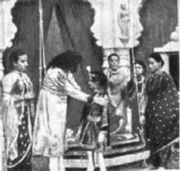Favorite Links
NOW WATCH HISTORY OF INDIAN SILENT CINEMA ON FIRST INDIAN SATELLITE NEWS CHANNEL VOICE OF NATION BY DR.R.K.VERMA FILMOLOGIST
The Indian film industry is the largest in the world in terms of the ticket sales and the number of films produced annually (877 feature films and 1177 short films were released in the year 2003 alone).[1] In contrast, 473 films were produced in the US in 2003.[2] Movie tickets in India are among the cheapest in the world.[3] India accounts for 73% of movie admissions in the Asia-Pacific region, and earnings are currently estimated at US$2.9 billion.[citation needed] The industry is mainly supported by the vast cinema-going Indian public. The Central Board of Film Certification of India cites on its website that every three months an audience as large as India's billion-strong population visits cinema halls.[4] Indian films are popular in various parts of the world, especially in countries with significant Indian communities.
1896 - 1910
Cinema was introduced to India on July 7, 1896. It began with the Lumiere Brothers' Cinematography, unveiling six silent short films at the Watson Hotel in Bombay, namely Entry of Cinematographe, The Sea Bath, Arrival of a Train, A Demolition, Ladies & Soldiers on Wheels and Leaving the Factory[1]. The Times of India carried details of the "Living Photographic Pictures in Life-Size Reproductions by Mssrs. Lumiere Brotheres". In the same year, the Madras Photographic Store advertised "animated photographs". Daily screenings of films commenced in Bombay in 1897 by Clifton and Co.'s Meadows Street Photography Studio.
In 1898, Hiralal Sen started filming scenes of theatre productions at the Classic Theatre in Calcutta, inspired by Professor Stevenson (who had brought to India the country's first bioscope)'s, film presentation alongside the stage production of The Flower Of Persia; his debut was a contribution to this presentation. He continued making similar films to complement theatrical productions, which were shown as added attractions during intermission, in private screenings for high society households or taken to distant venues where the stage performers could not reach.
Harischandra Sakharam Bhatavdekar (H. S. Bhatavdekar) alias Save Dada, who had attended the show, imported a cine-camera from London at a price of 21 guineas and filmed the first Indian documentary, a wrestling match in Hanging Gardens, Bombay, in 1897. In 1901, he recorded the return from Cambridge of 'Wrangler' Ragunath P. Paranjpye, who had secured a distinction in mathematics from Cambridge University, and M M Bhownuggree, considered the first Indian news film. [2][3]. He also filmed Lord Curzon (the Viceroy of India)'s Delhi Durbar that marked the enthronement of Edward VII in 1903.
The introduction of cinema in India ....... The Moving Expressions !!!!!!!!!!
The first feature film made in India was a narrative named Pundalik, by N.G. Chitre and R.G. Torney. The first full-length Indian feature film was Raja Harishchandra (3700 feet as compared to 1500 for Pundalik), made in 1913 and released commercially in May that year, by Dadasaheb Phalke. Phalke had attended a screening of The Life of Christ at P.B. Mehta's American-Indian Cinema and was inspired to make films himself. He was convinced of the possibility of establishing an indigenous film industry by focusing on Indian themes. In this regard, he said Like the life of Christ, we shall make pictures on Rama and Krishna. The film was about an honest king who for the sake of his principles sacrifices his kingdom and family before the gods, who are impressed with his honesty and restore him to his former glory. The film was a success, and Phalke went on to make more mythological films till the advent of talkies, and commercialization of Indian films lessened his popularity.[4].
In 1916, Universal Pictures set up Hollywood's first Indian agency (see Hollywood meets India, below). The first South Indian feature was Rangaswamy Nataraja Mudaliar's Keechaka Vadham, released in 1918.[5] The following year, he made the film Draupadi Vastrapaharanam, featuring Anglo-Indian actress Marian Hill who played the role of Draupadi.


